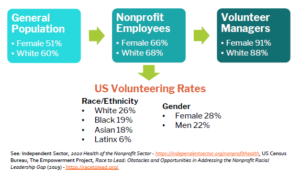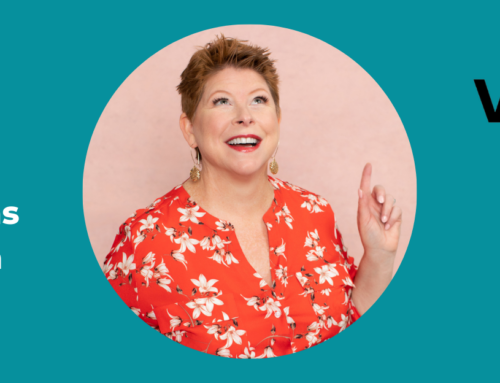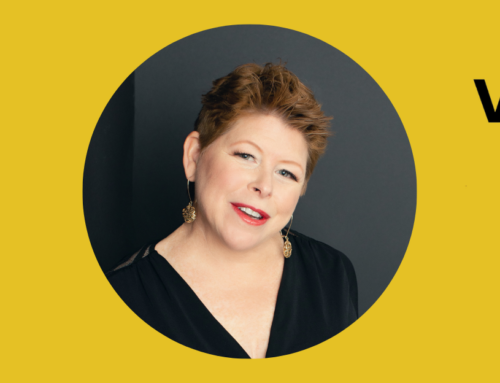Addressing Issues of Equity in Volunteerism: Where to Look & What to Do
Every year, the results of our Volunteer Management Progress Report survey reveal a troubling trend: lack of diversity among those who work in our sector which, we fear, may also result in issues of equity in volunteerism as a whole.
Year over year, respondents continue to be white (84%) women (88%). This trend has continued for six years, suggesting that we will continue to experience issues finding equity in volunteerism.
This lack of diversity isn’t limited to leaders of volunteers, either. This trend represents less employee diversity than in the US nonprofit sector as a whole.
As a point of comparison, recent data shows that 66% of sector employees are women, and 68% are white. Volunteer managers are a more homogenous group than nonprofit staff, in general. And, while people of color are roughly 40% of the population, 32% of nonprofit employees are people of color, which is double the number of those who work in volunteerism.
When thinking about this lack of diversity in the field, one might wonder, does this have an impact on who becomes a volunteer? Does it influence who sees opportunities, and who invites their friends, reinforcing the cycle of sameness?
Research shows that this may indeed be the case.
Volunteering data in the US shows that volunteers also look like those who engage them – White (26.4% versus 19.3% Black, 17.9% Asian, and 5.5% Latinos/as), educated (65.3% with at least some college education), and women (27.8% versus 21.8% men).

So, what can we each do to bring about more equity in volunteerism? As it turns out, plenty. And, we don’t need an expansive diversity, equity, and inclusion plan to get started.
There is an array of simple, and not so simple, steps we, as leaders of volunteers, can take to address injustice. Starting with examining the implicit bias that might be inherent in ourselves.
Everyone has their implicit biases – our unconscious attitudes or stereotypes that, favorably or unfavorably, affect our understanding, actions, and decisions.
Only when we take steps to become aware of our implicit bias and address it can we become better equipped to realize access to volunteering for all by addressing institutional bias on a greater scale.
Wondering about your blind spots? You can take an implicit bias test here.
Once you understand where your biases might be, you can start tackling issues of equity in volunteerism at your organization and in your community by addressing it at every step of the volunteer lifecycle.
Barriers to Volunteer Service
We talk a lot about the motivations to volunteer; however, how much do you know about the other side of the coin – the barriers to volunteering?
Even if you have worked hard to create a warm, welcoming organizational culture, and have worked hard to showcase how powerful your mission is to the community you serve (and how volunteers contribute to that mission), volunteers still must overcome barriers and worries before they will commit to your organization.
And, if you don’t work through strategies to address those barriers your organization will be leaving valuable volunteer talent on the table.
If you want to overcome those barriers you need to do a few things:
Become aware of the common barriers to volunteering with a lens toward marginalized groups. They will vary from person to person based on their own past experiences and current set of life challenges. They might also be related to the volunteer’s sense of self-identity and sense of self. Here is a list of some common barriers, courtesy of The Denver Foundation’s Inclusiveness Project:
-
- Not being asked.
- Fear of being used as a token.
- Not feeling connected to the mainstream community.
- Lack of personal time.
- Cultural emphasis on family involvement over community involvement.
- Lack of identification with agencies serving communities of color.
- Lack of knowledge about volunteer opportunities.
- Belief that input from communities of color is not taken seriously.
- Uncertainty about the benefits of involvement.
- Economic hardship
Don’t brush these barriers aside because you don’t think they are real or don’t apply to your organization and/or opportunities. Think about how you can address them right off the bat with your recruitment efforts. Your recruitment materials should work to calm a potential volunteer’s anxieties.
Consider the language and photos you use to describe your volunteer opportunities. Who is pictured? Can you use them to answer some of the questions that arise? What about testimonials from other volunteers and people you serve; can they help?
Think beyond who you invite to serve. Recruitment is only one part of the volunteer engagement cycle. So, once your recruitment appeals are updated, follow the process below to help you think about and address power inequalities in every step of the volunteer engagement cycle at your organization.
Address Power Inequalities in the Volunteer Engagement Lifecycle

Beyond recruitment, what can you do to eliminate some of the barriers to volunteering? Look at the volunteer engagement cycle at your organization and think of ways you can address power inequities at every level.
Power inequalities exist in every society. It’s important to note that inequity is different than inequality.
According to Maire Dugan, Director, Race Relations 2020, Columbia, South Carolina:
“Inequality refers to a distribution of some good within in which some obtain more than others. Inequity goes beyond this: the distribution is not only unequal; it is unfair and unjust.”
There are three types of inequity that may exist in your volunteer program: power, wealth, and knowledge. This inequity stretches to nearly every aspect of society – including an individual’s willingness and ability to get involved as a volunteer.
Read on for more information on what kinds of barriers and power inequities might exist at your organization. Then, take some time to really think about how they might show up at your organization and write a list of ways you can create more equity in volunteerism.
Needs Analysis
When you conduct a needs analysis, you are deciding which volunteer roles are needed at your organization, and which staff will support those volunteers.
After conducting a needs analysis, take a deeper look at the roles you have determined a need for and ask yourself these questions:
-
- Are all people, regardless of circumstance, able to participate in these roles?
- What kind of accommodations can I put into place to ensure that everyone can participate in these roles comfortably?
- Are the roles flexible enough (scheduling-wise) for everyone to participate in a meaningful way, regardless of their work schedule?
- Are those served by your agency considered talent that might be engaged in service, or only passive beneficiaries of it?
Once you have looked at how you might be creating barriers to volunteering, based on your vision of what roles can be filled by whom, you can begin to consider ways you can weave more equity into your organization through the rest of the volunteer lifecycle.
Recruitment
Before volunteer recruitment can begin, one of the most time-consuming tasks is developing the volunteer position descriptions. Volunteer position descriptions are important in that they map out clear expectations and communicate clear, fair boundaries for volunteers.
They help the volunteer answer that all-important question: “Will this work matter?” They also help volunteers understand what’s expected and how they can integrate the time requirements into their busy lives.
A solid volunteer position description should explain the assignment thoroughly, outline the skills needed to perform the tasks successfully, and specify the type of training and support they will receive.
After creating your volunteer position descriptions, complete a bias check by asking yourself these questions:
-
- Do the minimum qualifications include experiences that can be learned on the job?
-
- Does it value lived experience as much as educational attainment or profession?
- Are educational requirements being used as a proxy for specific skills that could be attained through some other means?
- Does the language incorporate communication and management styles that are culturally and gender-inclusive?
Also, consider adding your organization’s Diversity, Equity, and Inclusion statement (typically found on paid position descriptions) in your volunteer position descriptions. If your organization doesn’t have one, work with your leadership team to develop one.
This is a task that should not be taken lightly. Learn more here on how you can build inclusiveness into your organization’s mission and vision.
Lastly, think about your outreach methods.
-
- Are you reaching out to communities of color and other marginalized groups?
- Can you build relationships with organizations or businesses that serve economically disadvantaged people, survivors of domestic violence, autistic people, people who are blind or visually impaired?
- Are there multicultural centers in your community that you can reach out to?
- Are their resource centers for people with disabilities that might offer some technical assistance and advice?
Screening
Thorough screening and proper placement of volunteers starts with asking the right volunteer interview questions. We often think about screening volunteers to mitigate potential risk, but it can also play into power inequalities that lead to a lack of diversity and equity in volunteerism.
Your unconscious bias may play a role in who is invited to become a volunteer at your organization.
Take some of the steps below to address power inequities and reduce bias in your screening process:
-
- Is a clear background check necessary for the role? If so, what kind of exceptions can you make if something comes back in the applicant’s history? Is there an alternate process for checking suitability, like additional reference checks? Make sure you have a clear policy for this, so you have alternatives for everyone who looks to volunteer at your organization.
-
- Are all of the interview questions relevant to the specific role and requirements? Don’t wing your volunteer interviews! Have a set of questions that you ask everyone who comes in for each role.
- Is there any ambiguity on the knowledge, skills, and/or ability that is required to succeed in the volunteer role? How will you consider it to be met? Can you make any exceptions to non-essential requirements?
- Avoid bias by sticking to a script. For example, affinity bias can show up if you connect with one candidate over another based on a shared interest.
Placement
Once you’ve decided an applicant is qualified to volunteer with your program, you will want to place them in the most well-matched position that meets your needs as well as the volunteer’s.
You may even have mutually agreed that the original volunteer position they applied for is not the best match, or you may decide to amend a role to better match a volunteer’s needs, availability, and accommodations. No matter what the process, both you and the volunteer should feel comfortable with the role you’ve agreed on.
Here’s how you can ensure that you are addressing power inequities in placing volunteers from underrepresented groups at your organization:
-
- Check your gender bias. Are you only bringing women in to work in social roles, such as fundraising or reading to children? Are you only placing men in roles helping your facilities staff maintain the property or to help with budgeting?
- Are you only placing volunteers that “fit in” with the program staff or your organization as a whole? This is considered confirmation bias, and it can hamper your ability to bring in a more diverse group of volunteers. Check out this video by Adam Grant for more information.
- Are you taking time with your decisions? Or are you placing the first person who comes along into your volunteer roles?
- Do your volunteer roles showcase your commitment to diversity? For example, does your organization make it a requirement that all board members donate a portion of their salary to your organization, leaving people with lower incomes out of the equation? Do you require volunteers to provide their own transportation as part of their role? If yes, you may be creating barriers for economically disadvantaged people to get involved.
Orientation & Training
Your volunteer orientation and training can be helpful and inspiring support for are all stages of volunteer involvement from newcomer to established volunteer to volunteer leader.
However, income, wealth, health, and racial inequity can impact how volunteer receive and respond to training.
Consider the following:
-
- Do you include transcripts of closed captions for all trainings, so that your volunteers with hearing impairments can follow along?
- Can your training materials be accessed without technology for those who don’t have access to a computer or internet connection?
- Are you using inclusive language and images in your training materials?
- Are you offering opportunities for ALL volunteers to learn skills on the job that can help them advance to leadership roles within the organization? Or are you reserving those opportunities for people who meet certain criteria, which can hold other volunteers back (for example, educational requirements, or professional certifications).
- Are you using clear and concise language that is easy for a non-native English speaker to follow?
- Have you included both formal and informal learning methods to appeal to a larger audience?
Supervision
Volunteer supervision can often be one of the more challenging aspects of engaging volunteers. It takes exceptional leadership skills. Some might argue that those that supervise volunteers need better leadership skills than those that support paid employees.
There is a power imbalance between volunteer leader and volunteer, and if a volunteer is from an underrepresented group, that imbalance is even greater.
Here are some tips to help you regain some balance:
-
- Leaders need to explicitly support racial justice and equity at every level of the organization.
- Offer training opportunities for all staff to learn about their implicit biases and how they can be allies for equity.
- Raise awareness and seek to close the gaps in how groups are represented in leadership positions at your organization. By seeing diversity at this level, volunteers will feel more welcome and comfortable.
- Think about how you as a leader are assigning work. Studies show that White men don’t have to work as hard to prove themselves in the workforce. So, think about who at your organization takes on undervalued tasks, such as filing/paperwork, meeting planning, taking notes, making coffee, mentoring, serving on minor committees, and leading low-impact projects. If it’s minorities, it’s time to make a change in who gets access to leadership roles.
- Consider your performance management system. Instead of annual or biannual check-ins, consider meeting weekly or monthly to review goals and, more importantly, celebrate achievements. The community you serve is constantly evolving. Likewise, so should your performance management.
- Communicate your goals and visions to volunteers in a way that makes them part of your unified team that will help you realize them.
Recognition
Volunteer appreciation and recognition is important to show that you value a volunteer’s commitment and effort. It can come in many forms:
-
- a simple verbal acknowledgment for great work
- formal thank-you note
- an organized volunteer appreciation event
- a volunteer awards ceremony
- or promotions to volunteer leadership positions
Here are some ways you can ensure your program follows equitable recognition procedures, versus giving a feeling of favoritism in how you recognize your volunteers.
-
- Ensure each volunteer award you give is based on measurable results. Don’t give your Volunteer of the Year award to someone the Board or CEO recommends because they think it will be “good for business.” Set a process and follow it, no matter what.
- If your process consistently rewards the same types of volunteers, it’s time to take a second look and revise it.
- Take a look at who is moving up the volunteer leadership ranks. Are the volunteers being promoted the ones favored by your staff? Or are they the ones who are putting in the work and getting the results? Ensure all promotions are earned, not simply given as favors or because they are liked by staff.
- Planning a formal event? Remove barriers for participation by sending out a survey and asking your volunteers what they want and what they can do. If you are serving food, offer options for those with dietary restrictions. If you are showing a video, ensure you have options for your visually impaired and hard of hearing volunteers to watch and listen.
- If your organization highlights volunteers as part of your marketing efforts, are you including everyone in those opportunities? For example, do your administrative volunteers, who typically work behind the scenes, have the same opportunity for visibility as a fundraising event planning volunteer?
Next Steps: Address Equity in Volunteerism

The suggestions mentioned above are just the beginning on how you can start creating equitable opportunities that offer everyone, regardless of circumstance, the opportunity to volunteer.
Here’s a roundup of next steps you should take to start building a more diverse and equitable volunteer force at your organization, and in your community as a whole.
- Check out these blogs: A Guide to Promoting Inclusive Volunteering: It’s About Power People, Building Bridges to Better Volunteer Diversity & Inclusion , Nonprofit Leadership Best Practices: Advocating for Equity in Troubled Times
- Listen to this Time + Talent Podcast Episode in which Dr. Helen Timbrell shares her research on the experience volunteers of color have in organizations in the UK. Hadji Singh shares his experience as a volunteer and a research participant.
- Review this inclusive language guide and start utilizing equitable terms throughout your everyday communications and your volunteer program materials.
- Take Implicit Bias Tests to determine if you have any unconscious biases that may be impacting how you work with volunteers.
- Complete the volunteer worksheets on the Denver Foundation’s Inclusiveness Project website to help you develop an action plan for increasing diversity, equity, and inclusion at your organization.
- Check out The Minnesota Association for Volunteerism (MAVA) Inclusive Volunteerism Initiative – This resource hub also includes a Racial Equity and Inclusion Resources for Volunteer Engagement Leaders list as well as the results of their 2017 study 8 Strategies for Creating a More Inclusive Volunteer Program.
Inequity in volunteerism certainly won’t be overcome overnight. But we are even less likely to attract volunteers from all walks of life if we are unable or unwilling to do the work it takes to examine our own biases and barriers.
And, this is important work, not only for our organizations but also for our communities.
If everyone does their part, we will begin to see a changing demographic in philanthropy and a world where empathy rules and intolerance has no place.









Leave A Comment